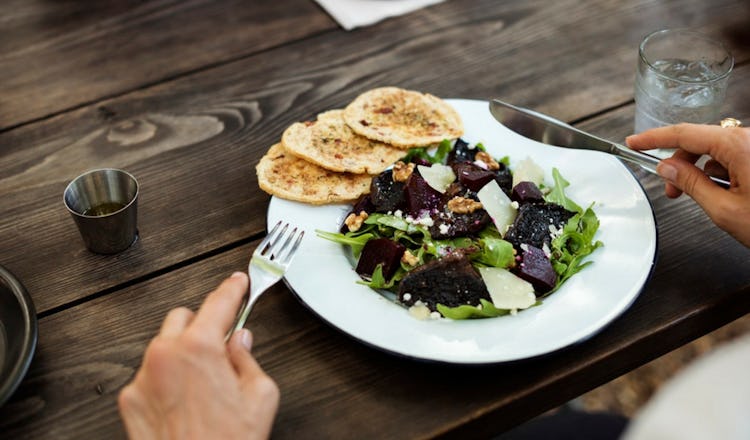At first blush, vegans and ketogenic dieters don’t have a lot in common. One eats no meat; the other eats tons of it. One loads up on carbs; the other takes pains to avoid them. They seem to be on opposite ends of the eating spectrum.
But what if you’re passionate about animal rights and still want to be lean and healthy, and you’ve found that your body just doesn’t do well on carbs? Is it possible to combine these approaches? Can a person go vegan as a keto dieter or keto as a vegan?
The short answer is yes, but it’s not easy. Trying to align two disparate eating philosophies will force you to walk a fine line—particularly in a world of readily-available animal products and high-carb foods. It’s an impressive feat to pull off. And, potentially, great for both your health and the environment.
So, if you’re interested in being vegan and keto, here’s how to do it.
The Complete Vegan Keto Diet and Food List

What Is A Vegan Keto Diet?
First, let’s be clear about what these terms “vegan” and “keto” really mean.
Vegans consume no animal products. Like vegetarians, they don’t eat meat, poultry, or fish, but they also avoid dairy, eggs, and other foods that contain even trace amounts of animal ingredients. Most vegans won’t eat gelatin (made from bones), casein (a milk protein), and fish oil supplements, or refined sugar (some brands of which use cow bones as a whitening agent).
There are many benefits to a vegan diet, including some that affect health and longevity. The authors of a 2016 study found evidence that reducing animal-based foods (when they’re conventionally raised on factory farms, that is, not organic) may reduce the incidence of diabetes, obesity, cataracts, and heart disease. Other people go vegan for ethical reasons, believing animal consumption to be cruel and harmful to the environment.
Now, what about those keto guys and gals?
Ketogenic diets originated in the 1920s as a treatment for epilepsy, but they’ve since been credited for promoting a number of health benefits ranging from improved insulin sensitivity to everyday mental clarity, in addition to fast weight loss. Strict ketogenic—or “keto”—dieters limit carbohydrate intake to about 5% of their daily calories while keeping protein intake at around 20%. Fats, then, make up close to 75% of their calories. (For more details on setting up various ketogenic diets, see our guide HERE.)
Restricting carbs and relying on dietary fat causes the liver to convert fat into molecules called ketones, which are used as fuel. When ketones show up above a certain threshold in your urine or in a breath test, you’re officially in what’s known as ketosis, and your body is running on ketones.
One big reason people go keto is sustained energy. When you don’t eat copious amounts of carbs, levels of insulin—the hormone that controls blood sugar—remain much steadier than they do on the carbohydrate-based diet most people are used to. When your blood sugar is stable, you don’t have afternoon energy crashes that make you want to fall asleep at your desk. A study in the Annals of Internal Medicine showed that a ketogenic diet controlled blood sugar more effectively than a more standard, low-calorie diet that was high in carbs.
Keto diets may also make it easier to burn extra fat off your waistline. Research from 2013 in the British Journal of Nutrition found that keto dieters lost more weight long-term than those who ate a low-fat diet.
Of course, one of the big complaints about a keto diet is that—like a vegan approach—it’s very restrictive and can be hard to stick to. That’s why we like to make people aware of a slightly less rigid approach we call Mod Keto that offers much of the same benefits as a strict keto diet but is much easier to follow long-term. With Mod Keto, carbs are raised to about 20% of your total caloric intake, protein to 20–40%, and fat is reduced to 40–60%. While not technically ketogenic (your body will probably not produce appreciable ketones at these levels), the higher protein and carb allowance supports workouts and activity better while still stabilizing blood sugar and promoting fat burning.
So we’ve got vegan and we’ve got keto¦ Put them together and you’ve got a plan that has you eating a higher-fat, lower-carb menu that is also devoid of animal products.
It sounds simple enough in theory, but the two approaches can be contradictory. Low-carb, high-fat meat, fish, and poultry are staples for keto dieters, but they don’t work at all for vegans. Meanwhile, high-protein legumes and meat substitutes are go-to’s for vegans, but their carb content makes them verboten for keto adherents.
How, then, does a person balance the two?

The Vegan Keto Food List
The goal for the vegan keto-dieter is to eat:
- plenty of plant-based fats
- some plant-based proteins
- as few carbs possible
Below are some foods that fit the vegan-keto bill nicely, courtesy of Liz MacDowell, N.C., founder of meatfreeketo.com. “This is basically every vegan keto-friendly whole food in your typical North American grocery store,” she says, “which can help take care of the what-can-you-eat-on-vegan-keto question.”
Good protein sources are marked with a “p”, while foods that have a higher-carb content (and should, therefore, be eaten sparingly) are marked with an asterisk (*).
Nuts
- Almonds*
- Brazil nuts
- Hazelnuts/filberts
- Macadamia nuts
- Pecans
- Peanuts*
- Pine nuts*
- Walnuts
Seeds
- Chia
- Hemp
- Pumpkin
- Sunflower
Nut & Seed Butters
- Almond butter
- Coconut butter/coconut manna (“meat” of the coconut)
- Hazelnut butter
- Macadamia nut butter
- Peanut butter
- Pecan butter
- Sunflower seed butter
- Tahini Walnut butter
Other Whole-Food Fat Sources
-
-
- Avocados
- Coconuts
- Olives
-
Healthy Oils
-
-
- Almond oil
- Avocado oil
- Cacao butter
- Coconut oil
- Flaxseed oil
- Hazelnut oil
- Macadamia nut oil
- MCT oil
- Olive oil
-
Vegetables
-
-
- Artichoke hearts
- Arugula
- Asparagus
- Bell peppers
- Beets*
- Bok choy
- Broccoli
- Brussels sprouts*
- Cabbage
- Carrots*
- Cauliflower
- Celery
- Celeriac*
- Chard
- Collards
- Cucumbers
- Daikon radish
- Dandelion greens
- Eggplant
- Endive
- Fennel
- Fiddleheads
- Garlic
- Jicama*
- Kale*
- Kohlrabi
- Lettuce (all types)
- Mushrooms
- Mustard greens
- Okra
- Onion
- Radishes
- Rhubarb
- Rutabaga*
- Shallots
- Spinach
- Squash—winter*
- Squash—summer
- Swiss chard
- Turnips
- Zucchini
-
Fruits
-
-
- Avocados
- Blueberries*
- Coconuts
- Cranberries
- Lemons
- Limes
- Olives
- Raspberries
- Strawberries
- Tomatoes
- Watermelon
-
Sauces & Condiments
-
-
- Chili sauce
- Hot sauce
- Hummus*
- Mustard
- Soy sauce/tamari
- Salsa
- Tomato sauce
- Vinegar
-
Vegan Keto Fridge Staples
-
-
- Apple cider vinegar
- Dairy-free yogurt*
- Dairy-free cheese*
- Pickles
- Micro-greens
- Sauerkraut
- Seitan*(p)
- Sprouts (all kinds)
- Tempeh (p)
- Tofu (p)
-
Vegan Keto Pantry Staples
-
-
- Almond flour
- Artichoke hearts
- Baking powder
- Baking soda
- Coconut flour
- Coconut milk (canned, full fat)
- Cocoa or cacao powder
- Dark chocolate (85% and up)
- Glucomannan powder
- Hearts of palm
- Jackfruit (green, canned in brine)
- Psyllium Husk
- Nutritional yeast
- Vanilla extract (most brands OK, but check for sugar)
-
Other Vegan Keto Meal Staples
-
-
- Herbs and spices
- Edamame
- Kelp noodles
- Kelp flakes
- Lupini beans*(p)
- Shirataki noodles
- Nori sheets
- Roasted seaweed
-
Foods You CAN’T EAT On A Vegan Keto Diet
-
-
- Meat, fish, poultry, dairy, eggs, other animal products
- Gelatin
- Sugar (refined, cane, honey, corn syrup, and all other forms)
- Grains (wheat, pasta, rice)Legumes (beans)
- Starchy vegetables (yams, potatoes)
- High-carb nuts (chestnuts, cashews, pistachios)
- Partially-hydrogenated oils (trans fats)
- Refined vegetable oils**
-
**Even though they’re not derived from animals and are high in fat, oils such as canola, corn, rapeseed, and margarine are highly processed and have a poor ratio of omega-3 to omega-6 fatty acids. They promote inflammation in the body. Because they have low smoke points, these oils are also terrible choices for cooking. High heat will turn the fats in the oil rancid, and make it even more unhealthy, causing damage to your heart, neurological problems, and other health woes. Always cook with saturated fats, such as those found in coconut and red palm oil.

How Do I Limit Carbs on a Ketogenic Vegan Diet?
In our sandwich-with-a-side-of-bread culture, cutting carbs down to the wire trips many people up. “Exact numbers vary person to person, but in general, strict keto dieters need to consume less than 50 grams of carbs a day,” says exercise physiologist Michael T. Nelson, Ph.D. (miketnelson.com). “Some people need to go as low as 30 grams.” The Mod Keto approach allows two to three times as many, but it’s still very low-carb compared to the diet of the average American. (For reference, one banana, one apple, or a single slice of bread would put you over your daily carb allowance on a strict keto diet.)
Cutting out grains, rice, bread, and pasta will reduce your carb intake substantially, but you’ll also have to cut way back on nearly all fruits (exceptions are in the food list above, though even those should be eaten sparingly). Starchy vegetables like potatoes and yams are out, too. And the sugary dressings and sauces you may be so accustomed to that you don’t even question them anymore¦ well, start questioning them.
If you’re longing for carbs so badly that you feel your resolve to stay on the diet is breaking, it’s possible to trick your brain that you’re eating them by making approved foods look more like your starchy favorites. Cauliflower can be grated into “rice,” or boiled and mashed like potatoes. You can slice zucchini into noodles to (sort of) replicate pasta. See “Vegan Substitutions for the Keto Diet” below.
But by and large, you’ll simply have to develop a taste for fattier foods and rely on them to supply energy in place of carbs. Avocados, coconut oil, and nuts are all filling, flavorful options that can also power your workouts.
And speaking of working out, if you’re a gym rat or avid runner, prepare for your workouts to suck for a while until your body fully adapts to the diet. If you’re cutting out carbs for the first time, your body will need two weeks or more (and sometimes months) to fully support the demands of exercise with ketones. And if you’ve been relying on animal products, you may find it difficult to recover without the full array of amino acids that every serving of animal protein provides. You’ve chosen a hard road to travel, nutritionally, but don’t lose heart. Time and persistence will force your body to accommodate just about any regimen you subject it to, and there are plenty of people whose performance has thrived on unconventional diets.
A 2012 study found that gymnasts on a strict ketogenic diet for only 30 days lost weight without losing strength. The researchers concluded that keto eating may actually prove advantageous to athletes in weight-class sports since it could allow them to keep their strength up when competing at lighter body weights.

How Do I Get Enough Protein on the Ketogenic Vegan Diet?
For anyone following any vegan diet, and athletes especially, the question always comes up: “How do you get enough protein?” Nelson recommends about 0.7g of protein per pound of your goal body weight as a baseline daily intake for active people—and most nutritionists recommend up to one gram per pound if you’re weight training. (Goal body weight means the amount you want to weigh—not the number that currently comes up on the scale. So, if you weigh 205 pounds but remember looking and feeling your best when you weighed 175, eat 0.7g of protein x 175, or about 120 grams daily.)
Your main challenge will be to find plant-based protein sources to hit that number that isn’t also high in carbs.
To get an idea of what that entails, consider that an average-sized person who eats about 2,000 calories a day will need 100–200g protein daily (on the lower end for strict keto dieters, and on the higher side for those going the Mod Keto route). A three-quarter cup serving of sunflower seeds nets you 25–30g protein, but also costs you 10g of carbs. Almonds have a similar protein-to-carb ratio at 30g to 15g per cup. The key is to accumulate enough protein from vegan sources without letting your carbs creep up too high.
Your best bet for low-carb vegan protein may be hemp seeds, which provides 30g protein and 8g fiber (NOT counted as carbs) in a mere half cup. Seitan, which is made from wheat, is another good choice and offers about 18g protein and 2g carbs every three ounces. Tofu and tempeh rank high as well (tofu has an 8:1 ratio of protein to carbs; tempeh is about 6:1).
If you’re willing to go the supplement route, hemp and other vegan-sourced protein powders such as rice and pea, which have about a 5:1 protein-to-carb ratio, are the best choices and may be indispensable for athletes and workout fiends.
If you were doing a more conventional ketogenic diet previously and relying on animal foods, you may have only counted the protein in those foods toward your allotment for the day because they are complete sources. In other words, the protein in animal products contains all the essential amino acids that your body needs from food and in substantial amounts. This is a rare find in plant foods, and the reason that bodybuilders have historically kept track of the protein they eat from chicken, beef, and fish, but don’t consider the amount they take in from vegetables, grains, and nuts. The thing is, though, while they may be less bioavailable than animal foods, plant proteins are still usable by your body and still count toward your total—and if you’re going to forgo animal products entirely, you’ll need to get them in to support muscle, performance, and general health. Otherwise, you’ll be protein deficient.
Vegans have long known that they can’t get all the amino acids they need from one source of plant protein, so they make an effort to eat a diverse selection of them and often combine foods in the same meal to get a complimentary assortment of aminos. You don’t need to do this at every meal—your body can hold on to the aminos from one food a few hours until you eat another food with aminos that complement them and form a complete protein. But don’t get in the habit of basing your meals around only tofu or only hemp. Eat as broad a menu as you can to ensure the richest nutritional intake you can. (See more reasons to limit tofu under the vegan substitutes list below.)

Vegan Substitutes for the Keto Diet
If you’re already a keto eater used to animal products, the list below will give you ideas on how to switch to zero-cruelty food options while keeping carbs low. (Likewise, it will help vegans find lower-carb alternatives to their starchy or sugary favorites.) As always, be extra sure you’re staying faithful to the diet by checking labels for the presence of added sugar, carbs, and hydrogenated oils (harmful, processed fats that have no place in any healthy diet).
Replace the foods you’re currently eating in the left-hand column with those in the right-hand one.
Dairy foods
| Milk | coconut milk, almond milk |
| Cream | coconut cream |
| Butter | coconut oil/vegan butter |
| Eggs (for cooking) | flax seed (add water in a 1:3 ratio) |
| Eggs (for meals) | Silken tofu, Veggies |
Grains and starches
| Sandwich bread | lettuce wraps |
| Tortillas | flax tortillas |
| Pasta | Shirataki noodles, zucchini noodles |
| Rice | Cauliflower rice |
| Mashed potatoes | Cauliflower mashed potatoes |
| Oatmeal | “Noatmeal” (made with coconut flour, coconut butter, protein powder) |
| Cereal | Chia pudding, flax granola |
| Pancakes | Peanut butter pancakes |
| Waffles | Almond flour waffles |
Snacks
| Chips | Dehydrated vegetables (including kale chips) |
| Crackers | Chia seed crackers |
Desserts
| Ice cream | avocado ice cream, low-carb sorbet |
| Brownies | (macadamia nut, avocado, almond flour) |
| Pudding | Avocado pudding |
Processed soy-based meat substitutes (such as Boca Burgers) and protein powders are major go-to’s for people transitioning to vegan diets, but they come with a catch. A 2016 position paper published by Virginia State University explains that soy contains isoflavones, a kind of plant estrogen that can act like the female hormone in humans. While typical serving sizes (one to three of soy foods, or less than 25g of soy protein from non-concentrated sources like tofu) have not been shown to be problematic, amounts more than that (totaling around 100mg isoflavones or greater daily) could negatively impact testosterone. To our thinking, why take the risk? It may be best for a keto dieter to get the majority of his/her protein from nuts, seeds, vegetables, and supplements and less from soy products, apart from the occasional slice of tofu.
Dominic D’Agostino, Ph.D., one of the world’s foremost ketogenic diet researchers and founder of ketonutrition.org, agrees. “I generally avoid soy isolate and soy milk,” he says. “But I don’t think this is a major concern unless you are consuming large amounts of soy.” Note that fermented soy products—such as soy sauce and tempeh—don’t pose the same risk, and can, therefore, be eaten more liberally.
Vegan Keto Diet Sample Meal Plan
The following menu, courtesy of Dr. Nelson, will give you an idea of how a day of eating on a vegan keto diet could look (with a Mod Keto carb allowance). One thing’s for sure: you can eat a high volume of food without having to worry about taking in too many calories, so you’re unlikely to gain weight by accident with this style of eating. It’s easy to stay satiated due to the fat content and the abundance of fresh vegetables makes this diet rich in phytonutrients and fiber. On the downside, it’s very tough to get enough protein in. As you can see, aiming for the bare minimum amount—20% of calories—almost certainly requires supplementation.
Breakfast
Smoothie made with:
Rice protein powder (30g protein)
½ cup mixed berries
1 tbsp MCT oil***
1 ½ tbsp almond butter
1 cup chaga tea
Lunch
3 servings tofu (300g)
2 cups asparagus, baked
2 tbsp MCT oil, as dressing
Snack
Salad with:
1 green bell pepper
2 cups cremini mushrooms
4 oz chopped onion
1 serving tempeh (100g)
1 tbsp olive oil
2 oz vegan teriyaki sauce
Dinner
Salad with:
2 cups spinach
4 oz cucumber
4 oz tomato
1 cup red cabbage, chopped
1 tbsp olive oil
¼ cup walnuts
Totals: 1,728 calories, 86g protein, 78g carbs, and 125g fat
***Whether you go full or Mod Keto, supplementing with MCT oil can help support ketosis by providing a quick-burning fat for fuel, says D’Agostino. Other helpful strategies for making a keto diet more user-friendly, he says, include “eating in a time-restricted window [such as 16 hours of fasting followed by an eight-hour period in which you get all your food in], and breaking the fast with a ketone supplement. You can have a whole-food vegan keto meal a few hours later.”
While it hasn’t been formally studied, “it is generally observed that, if you are keto-adapted,” says D’Agostino, “it is easy to fast for prolonged periods of time. This has practical benefits for occupations where stopping to eat would be an inconvenience—such as for military personnel—and jobs where you do not want to lose the flow of productivity.” If you do get hungry during a fast, D’Agostino recommends taking a supplement that provides ketones (known as exogenous ketones), which will help sustain ketosis and energy. “I typically take a ketone supplement late afternoon and follow up with a whole-food meal in the evening,” he says.

Common Vegan Keto Deficiencies (And How to Fix Them)
OK, you’ve banished nearly all carbs from your diet, kicked out the animal products, found a way to get all your protein in, and have fallen in love with avocados. You’ve pulled off the triple-Axel of diets¦ or have you?
In your admirable pursuit of both personal and planetary health, there’s still a good chance you may become deficient in one or more key nutrients essential for long-term health. These nutrients include:
Vitamin B12 (aka cobalamin)
It’s essential for your skin, eyes, hair, and nervous system, Metabolically, it helps you digest protein, fats, and carbs. Unfortunately, B12 is hard to come by in plant foods. Some decent vegan, lower-carb food sources include nutritional yeast, fortified almond milk (which only has 1g carbs/serving) and nori (purple seaweed, 0.5g carbs)
Still, most plant foods that offer B12 pack a lot of carbs at the same time (you’ll blow through 5g carbs getting your B12 RDA in nutritional yeast), so Nelson suggests getting the vitamin via a vegan supplement. Look for one that provides 6–10mcg of methylcobalamin (a form of B12), as opposed to cyanocobalamin, which is absorbed more readily
DHA and EPA
These omega-3 fats provide building blocks for cellular structures throughout the body and aid in the prevention of cardiovascular disease. Fish oil is the most common source of DHA and EPA, but a good vegan source—and one that, arguably, offers a better concentration of DHA—is algae (which is where those oily fish get their omega-3s from anyway). By supplementing with algae oil, you’re effectively cutting out the middle-fish. Aim for about 300mg/day.
Iron
This mineral is the key ingredient in hemoglobin, which transports oxygen from your lungs to the rest of your body. When levels get low, hemoglobin drops, and energy and vitality take a nosedive. Hair and nails get brittle and weak. If you’ve ever met a vegetarian who looks pale and routinely complains of exhaustion, low iron is often the reason.
Vegetable-sourced iron, known as non-heme iron, is harder to absorb than heme iron, which is found in animal products. This is why iron levels can plummet even when a plant-based dieter eats iron-rich foods like Swiss chard, nuts, and seeds. It’s wise, then, for vegan keto eaters to add a vegan-based iron supplement to their diets. This goes double for women, who lose some iron every month through menstruation. For women 19–50, 18mg of iron per day is recommended.

Vegan Keto Diet Recipes
Being a vegan keto dieter doesn’t have to limit you to salads and smoothies. It is possible to enjoy more gourmet fare by getting a little creative with how you prepare food. Liz MacDowell, a holistic nutrition consultant, and longtime keto dieter herself, offers up the following recipes, also available on her site meatfreeketo.com.
Vegan Chili “Fish” Tacos With Hempseed Sour Cream
For the “fish”:
1 can hearts of palm, drained, rinsed, and chopped
2 tbsp tamari, soy sauce, or liquid aminos
½ tsp garlic powder
½ tsp Sriracha or chili paste
1 tbsp sesame oil
For the hempseed sour cream:
1 cup hulled hempseeds
¼ cup lemon juice
¼ cup water
pinch of salt
Fixings
Romaine lettuce boats for taco shells
About a ¼ cup shredded purple cabbage
1 scallion, chopped
kelp flakes to taste (optional)
juice of 1 lime
Directions
1. Add all hempseed sour cream ingredients to a blender and process until smooth. Add water if you want a smoother, creamier texture. Set aside.
2. Place a saucepan over low heat and pour in the sesame oil. Add the hearts of palm mixture from step 1 and sauté until everything is warm and the excess liquid is absorbed (about 5 minutes).
3. Let the hearts cool a bit and then assemble tacos by layering the hearts in the lettuce boats first, then the cabbage, sour cream, and scallions. Sprinkle kelp flakes on top (if desired) and finish with lime juice.
Servings: 2, Calories per serving: 215, Protein per serving: 11g, Carbs per serving: 4g, Fat per serving: 16g
Vegan Keto Protein Brownies
Ingredients
1 ½ cups warm water
½ cup peanut butter
¼ cup sugar substitute
2 scoops plant-based protein powder
¼ cup cocoa powder
2 tbsp coconut flour
2 tsp baking powder
Instructions
1. Preheat oven to 350 degrees and coat a baking sheet with non-stick cooking spray. In a bowl, combine the water, peanut butter, and sugar substitute.
2. In a separate bowl, sift together protein powder, cocoa, coconut flour, and baking powder.
3. Mix the dry ingredients into the wet ones. A thick batter with a frosting-like texture will form.
4. Scoop the batter into the pan, smooth the surface, and bake 40–45 minutes (check that it’s done by inserting a knife; it should come out clean). Let cool before serving.
Servings: 8 brownies, Calories per serving: 157, Protein per serving: 12.5g, Carbs per serving: 4.2g, Fat per serving: 9g
Low-Carb Sandwich Bread (Soy-, Grain-, and Gluten-Free)
If going keto has you missing bread, this substitute offers much of the flavor and texture of real dough without the carbs or gluten.
Ingredients
½ cup psyllium husks
3 tbsp ground flax seed
1 tsp baking powder
pinch of salt (add up to 1 tsp if using unsalted peanut butter)
1 cup water
½ cup peanut butter (almond and sunflower seed butter work too)
Instructions
1. Preheat oven to 350 degrees. Add psyllium, ground flax seed, baking powder, and salt in a mixing bowl and whisk until thoroughly combined.
2. Add water to the mixture and continue whisking until all the water has been absorbed. Mix in peanut butter until the mixture forms a uniform dough.
3. Line a baking sheet with parchment paper. Scoop mounds of the dough onto the paper and flatten them into discs that are about a quarter-inch thick. Bake 60 minutes.
Servings: 4 rolls, Calories per serving: 252, Protein per serving: 9g, Carbs per serving: 4g, Fat per serving: 12.5g
Want even more recipe options? Pick up The Ketogenic Cookbook by Jimmy Moore. It’s the most comprehensive collection of tasty keto-friendly eats we’ve come across yet.

)





